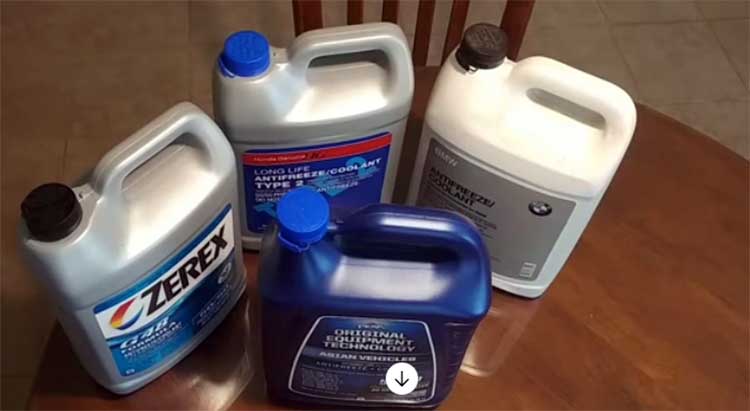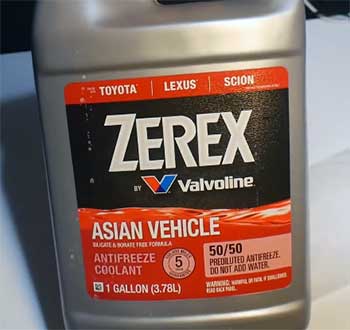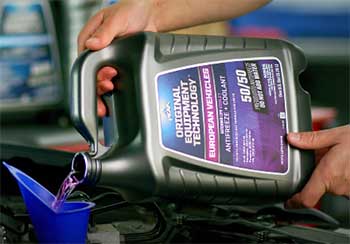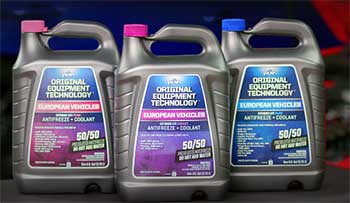As a car enthusiast who’s spent countless hours under the hood, I’ve learned that choosing the right coolant is crucial for keeping an engine happy. In this article, I’m breaking down Zerex vs. PEAK coolant from my own analytical perspective, sharing what I’ve discovered through hands-on experience and research. You’ll get a clear comparison of their pros, cons, and key features to help you decide which is best for your vehicle.
Whether you’re a DIY mechanic or just curious, let’s explore these two popular brands together and find the perfect coolant for your ride.

Comparison Table: Zerex vs. PEAK Coolant
| Feature | Zerex Coolant | PEAK Coolant |
| Base Formula | Ethylene Glycol (varies by type) | Ethylene Glycol (varies by type) |
| Types Available | IAT, OAT, HOAT, Asian, G-05, G-40 | OET, Asian, Universal, Long Life |
| Color Options | Green, Orange, Yellow, Red, Blue, Pink | Green, Red, Pink, Purple, Violet |
| Silicate-Free Options | Yes (e.g., Asian, G-40) | Yes (e.g., Asian OET) |
| Phosphate-Free Options | Yes (e.g., G-05, G-40) | Yes (e.g., Asian OET) |
| Service Life | Up to 5 years or 150,000 miles | Up to 5 years or 150,000 miles |
| Vehicle Compatibility | Broad, including American, Asian, European | Broad, strong focus on Asian vehicles |
| Price (per gallon) | $15–$30 (varies by formula) | $12–$25 (varies by formula) |
| Warranty | Limited, vehicle-specific conditions apply | Limited, excludes off-road use |
| Availability | Widely available, some formulas online-only | Widely available, retail and online |
My Journey with Engine Coolants
I still remember the first time I popped the hood of my old Toyota Tacoma, staring at the radiator and wondering what kind of coolant was keeping it from overheating. Back then, I didn’t know much about antifreeze, but after a few overheated engines and a lot of trial and error, I’ve become somewhat of a coolant connoisseur.
Zerex and PEAK are two brands that have crossed my path repeatedly, and I’ve used both in various vehicles over the years. They’re reliable, widely available, and cater to a range of engines, but they’re not identical. Let’s break down what makes each stand out and where they fall short.
Understanding Coolant Basics
Before I get into the specifics of Zerex and PEAK, let’s talk about what coolant does. It’s not just colored liquid sloshing around in your radiator. Coolant, or antifreeze, is a mix of water and chemicals (usually ethylene glycol) that prevents your engine from freezing in winter or boiling in summer.
It also protects against corrosion, lubricates moving parts like the water pump, and keeps your cooling system clean. The wrong coolant can clog your system, damage gaskets, or worse, lead to engine failure. That’s why choosing between brands like Zerex and PEAK matters.
Zerex Coolant: A Closer Look
Zerex, made by Valvoline, has been a staple in my garage for years. It’s one of those brands you see everywhere—AutoZone, Walmart, even the corner auto shop. What I like about Zerex is its variety. They offer formulas for just about every vehicle, from my old ’99 Tacoma to a friend’s BMW.
Here’s what I’ve found about Zerex after using it in multiple cars.

Key Features of Zerex
- Wide Range of Formulas: Zerex covers Inorganic Additive Technology (IAT) for older cars, Organic Acid Technology (OAT) for newer models, and Hybrid OAT (HOAT) for vehicles like Fords and Chryslers. Their Asian formula is a go-to for my Toyota, and the G-05 is perfect for European diesels.
- Color-Coded Options: Zerex uses colors to indicate compatibility—green for traditional, orange for OAT, yellow for HOAT, and so on. This makes it easy to match with your vehicle’s needs.
- Long Service Life: Most Zerex coolants last up to 5 years or 150,000 miles, which means less frequent flushes.
- Phosphate- and Silicate-Free Options: Formulas like G-05 and G-40 are free of phosphates and silicates, reducing the risk of corrosion in aluminum engines.
- Bittering Agent: Zerex adds a bitter taste to deter pets and kids from ingesting it, a small but thoughtful touch.
Pros of Zerex
- Versatility: I’ve used Zerex in everything from a Subaru to a Dodge Ram, and it’s never let me down. Their Asian formula, in particular, is spot-on for Japanese vehicles.
- Proven Track Record: Zerex has been around for decades, and I’ve seen it recommended by mechanics and Porsche enthusiasts alike.
- Corrosion Protection: The anti-corrosion inhibitors in Zerex keep my radiator and water pump clean, even after years of use.
- Availability: You can find Zerex almost anywhere, though some specialty formulas like G-40 might require an online order.
- Clear Labeling: Zerex’s bottles clearly state which vehicles they’re for, so I don’t have to guess.
Cons of Zerex
- Pricey for Some Formulas: The Asian or G-40 formulas can cost up to $30 a gallon, which stings compared to OEM coolants like Toyota’s.
- Confusing Color Variations: While the color-coding helps, it can be overwhelming if you’re not sure whether your car needs red, pink, or blue.
- Warranty Limitations: Zerex’s warranty is strict, requiring your engine to operate within specific conditions, which can be a hassle if you’re modding your car.
- Not Ideal for Mixing: If you top off with the wrong Zerex formula, you risk gelling or reduced performance, so you need to flush thoroughly before switching.
PEAK Coolant: My Experience

PEAK is another brand I’ve come to trust, especially after Walmart started stocking it over Zerex in some stores.
It’s made a name for itself with its Original Equipment Technology (OET) line, which targets specific vehicle makes, particularly Asian models.
I’ve used PEAK Asian Red in my wife’s Lexus and their Universal coolant in a friend’s Jeep. Here’s what stands out.
Key Features of PEAK
- OET Formulas: PEAK’s OET line is designed to match OEM specifications for Asian, European, and American vehicles. Their Asian Red is a favorite for Toyotas and Nissans.
- Affordable Pricing: PEAK is generally cheaper than Zerex, with gallons ranging from $12 to $25 depending on the formula.

- Silicate-Free Asian Formulas: Like Zerex, PEAK’s Asian OET is silicate-free, making it safe for aluminum engines. It also avoids 2-EHA, a chemical linked to gasket issues.
- Temperature Range: PEAK claims protection from -34°F to 265°F, which I’ve found reliable even in harsh Midwest winters.
- Pre-Diluted Options: Many PEAK coolants come pre-mixed 50/50, so you don’t need to mess with distilled water.
Pros of PEAK
- Cost-Effective: PEAK is often $5–$10 cheaper per gallon than Zerex, which adds up if you’re flushing multiple vehicles.
- Asian Vehicle Focus: I’ve had great results with PEAK Asian Red in my Lexus and Nissan. It’s formulated to match OEM specs without the dealership price tag.
- Easy to Find: PEAK is stocked at major retailers like Walmart and AutoZone, making it convenient for last-minute top-offs.
- No 2-EHA in Asian Formulas: This gives me peace of mind, especially for older cars where gasket leaks are a concern.
- User-Friendly: The pre-diluted options are a lifesaver when I’m in a rush and don’t want to measure water.
Cons of PEAK
- Limited European Options: While PEAK’s Violet OET works for some European cars, it’s not as comprehensive as Zerex’s G-05 or G-40 for BMWs or Mercedes.
- Warranty Restrictions: PEAK’s warranty excludes off-road use, which is a bummer for my Jeep-owning friends.
- Less Proven Track Record: PEAK doesn’t have the same long-standing reputation as Zerex, and some mechanics are hesitant to recommend it.
- Color Confusion: Like Zerex, PEAK’s multiple colors (red, pink, purple) can be confusing if you don’t know your vehicle’s requirements.
Head-to-Head Comparison
Now that I’ve laid out the features, pros, and cons, let’s compare Zerex and PEAK across key factors that matter to me—and probably to you.
Compatibility
Zerex wins for versatility. Its range of formulas covers American, Asian, and European vehicles with precision. I’ve used Zerex G-05 in a Dodge Ram and Zerex Asian Blue in a Subaru without issues. PEAK is strong for Asian vehicles, and its OET line matches OEM specs for Toyotas and Nissans, but it’s less robust for European models. If you own a BMW or Porsche, Zerex G-40 or G-05 is likely a better fit.
Performance
Both brands offer solid performance. Zerex’s corrosion inhibitors have kept my radiators spotless, even after 100,000 miles. PEAK’s Asian Red performed just as well in my Lexus, with no signs of rust or scaling. Both protect against freezing and boiling, but PEAK’s claimed temperature range (-34°F to 265°F) is slightly broader than Zerex’s typical -34°F to 250°F. In real-world use, I haven’t noticed a difference, but PEAK’s edge might matter in extreme climates.
Price and Value
PEAK takes the lead here. A gallon of PEAK Asian Red costs about $15–$20, while Zerex Asian Red can hit $25–$30. For budget-conscious folks like me, PEAK’s lower price is a big plus, especially since performance is comparable. However, Zerex’s wider compatibility might justify the cost if you own multiple vehicle types.
Ease of Use
PEAK’s pre-diluted options make it slightly more user-friendly. When I’m in a pinch, I can pour PEAK 50/50 straight into the radiator without mixing. Zerex offers pre-diluted formulas too, but many are concentrates, requiring distilled water. If you’re not comfortable mixing, PEAK is the easier choice.
Availability
Both are widely available, but PEAK has an edge in retail stores like Walmart, where it’s replaced Zerex in some locations. Zerex is still easy to find at AutoZone or online, but specialty formulas might require shipping. If you need coolant ASAP, PEAK is often the quicker grab.
My Real-World Experiences
To give you a sense of how these coolants stack up, let me share a couple of stories. A few years back, I flushed my Tacoma’s cooling system and refilled it with Zerex Asian Red. The process was straightforward, and the coolant kept my engine cool through a brutal summer road trip across the Southwest. No overheating, no corrosion—just smooth sailing.
Fast forward to last year, when I used PEAK Asian Red in my wife’s Lexus RX300. It was cheaper, pre-diluted, and just as effective. I checked the radiator recently, and it’s still clean as a whistle after 20,000 miles.
On the flip side, I once tried PEAK Universal in a friend’s Jeep Gladiator, and while it worked fine, I later learned Zerex G-05 would’ve been a better match for its MS-12106 spec. The Jeep didn’t complain, but I felt uneasy about straying from the OEM recommendation. Lesson learned: always check your vehicle’s manual.
Which Coolant Should You Choose?
Choosing between Zerex and PEAK depends on your vehicle, budget, and preferences. Here’s my advice based on my experiences:
- For Asian Vehicles: Both are excellent, but PEAK Asian OET is cheaper and matches OEM specs for Toyotas, Nissans, and Hondas. If you want a trusted brand with a longer track record, go with Zerex Asian.
- For European Vehicles: Zerex G-05 or G-40 is the safer bet for BMWs, Mercedes, or Porsches. PEAK’s Violet OET works for some European models, but it’s less specialized.
- For American Vehicles: Zerex HOAT or IAT formulas cover Fords, Chryslers, and GMs well. PEAK’s Universal or OET North American formulas are solid but less tailored for older models.
- For Budget Shoppers: PEAK’s lower price makes it a great value, especially for Asian vehicles or universal applications.
- For DIYers: PEAK’s pre-diluted options are more convenient, but Zerex’s clear labeling helps avoid mistakes.
Always flush your system before switching brands or formulas to prevent gelling or reduced performance. And check your owner’s manual—my biggest mistake early on was assuming all coolants were interchangeable.
Frequently Asked Questions (FAQ)
Zerex is excellent for its versatility and proven performance, but “best” depends on your vehicle. It’s ideal for Asian and European cars but can be pricey.
No single brand is best. Zerex and PEAK both shine, with Zerex offering broader compatibility and PEAK being more affordable. Check your vehicle’s specs.
The best coolant matches your vehicle’s OEM requirements. Zerex G-05 and PEAK Asian OET are top performers for their respective niches.
PEAK’s OET North American formula works for some Fords, but Zerex G-05 or HOAT is often a better match for Ford’s HOAT requirements.
Conclusion
After years of tinkering with engines, I can tell you that both Zerex and PEAK are solid choices for keeping your car cool and corrosion-free. Zerex’s versatility and long-standing reputation make it my go-to for a wide range of vehicles, while PEAK’s affordability and Asian vehicle focus are hard to beat. You can’t go wrong with either, but your decision should hinge on your car’s needs, your budget, and how much you value convenience. Check your manual, pick the right formula, and you’ll keep your engine purring for years to come. What’s your experience with these coolants? Let me know—I’m all ears!
